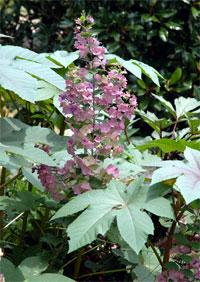Printed at http://www.dallasplanttrials.org/index.cfm/

Plant of the Month: Holmsolkia tettensis
Purple Chinese Hat Plant
Purple Chinese Hat Plant
AT A GLANCE
Latin name: Holmskioldia tettensis
Common name: Purple Chinese hat
Flowers: Purple and pink
Foliage: Green
Mature height: 5 ft.
Width: 4 ft.
Hardiness: Sub-tropical annual or tender perennial ( to Zone 8b)
Soil: Well-drained
Exposure: Full sun to partial shade
Water usage: Medium
Sources: Mail order and online
With winter fast approaching here in Texas, many of us are beginning to receive the first of our winter plant catalogs and e-mails. Strange how they start to appear when we have more time to be inside, tempting us with their glossy photos and promises to survive anything! To those of us with the “garden bug” these are the trying times — when our credit cards and relationships may easily be taxed to the max. Many a time I, too, have broken down to temptations over the years. Preciously purchased seeds, bulbs, and tiny plants, tossed about in boxes, have been delivered to my door like Christmas every spring, the result of my wintertime armchair plant hunting. Each little over-priced plant symbolizes some hope or dream of what my garden will become. I have to admit that over the years many of the plants I’ve found this way have succumbed to the Texas climate and have added to my ample compost pile, but a few have surprised me.
Holmskioldia tettensis is just such a surprise. Several years back I found this plant on the Internet (possibly the best garden tool ever invented) and thought it might make a cool summer tropical. The upright plants, native to North Africa, quickly grow to 4 to 5 feet tall and flower from early summer until frost. The blossoms resemble pointed straw Chinese hats, which is why the plant has taken that as its common name. Each flower has a 1-inch cupped, lavender-pink star with a blue butterfly sitting on top. You really have to see them to understand; maybe my photos will give you a better clue.
I kept my first purple Chinese hat plant for a few years, enjoying it in the summer as a container plant and moving it inside every winter. Then while traveling to East Texas one summer, I saw one in the Stephen F. Austin University Mast Arboretum, one of my favorite places to look/beg for cool plants. To my surprise, the staff had one growing in the ground that was just too big to have been hauled in during winter. My good friend who works there said they’d had it for a few years, hardy in the ground. Hmmmm, I thought. So much for believing what you read on plant tags. (I, too, forget that plants can’t read.) As soon as I got back to Dallas, I plopped ours right into the trial garden. Let’s just see how it does in a Dallas winter.
Guess what? It has survived the last three winters, freezing back to the ground and coming back each summer. I do imagine that as soon as we have a “real” winter, it will perish, but until then I’ll just consider each year a bonus. If you live north of Dallas, or in any area north of Zone 8a, it will most likely be a summer annual. (If it comes back for you, please let me know.) In warmer areas of the state, I’m sure this plant will definitely perennialize and reach 8 ft. or so over time.
Purple Chinese hat is also very easy to grow, tolerating full sun or part shade equally well. And it isn’t particular about soil pH as far as I can tell. Its water requirements don’t seem to be very high, but I do recommend fertilizing to get it to flower more. I like to mix it in summer containers with foliage plants to bring out the purple and blue colors of the flowers. Try Alternanthera ‘Purple Knight’ or Pseuderanthemum ‘Texas Tricolor’ to accent it.
I encourage you to do a little wintertime armchair plant hunting for yourself this winter, or send a gift certificate to a gardener you love and let them add something a little exotic to their garden. I really believe that some of the best-adapted plants to our extreme climate are available only via mail order. Those are the “ugly duckling” plants that won’t look good in a 4-inch or 1-gallon pot at the nursery, but truly grow into showstoppers in your garden.
To purchase this plant, I recommend just typing the Latin name into Google and adding “mail order” to it. I see online that the folks at Caldwell Nursery in Caldwell, Texas, like purple Chinese hat as much as I do and have it for sale. And check out the Stephen F. Austin Mast Arboretum Plant Sale next spring; I see they have it listed, too.
